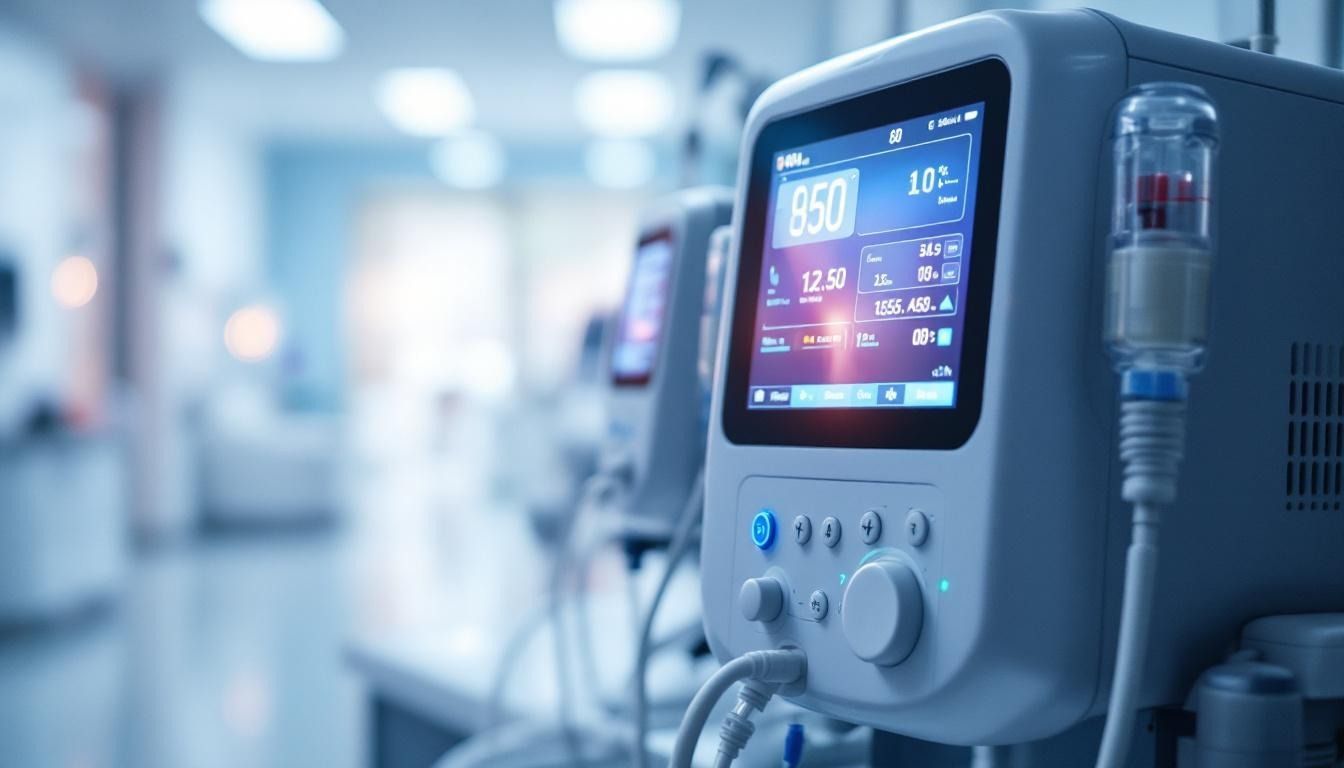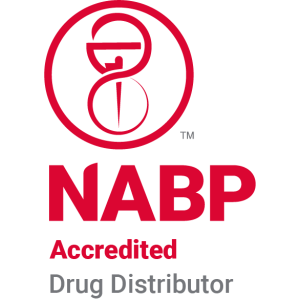Indications for Using Total Parenteral Nutrition (TPN) in Medical Treatment
Understanding When and Why TPN Is Used
Total Parenteral Nutrition (TPN) stands as a vital intervention in contemporary clinical practice, especially when the gastrointestinal (GI) tract cannot be utilized for nutrition. Its applications span a wide array of medical conditions, emphasizing the importance of precise indications, vigilant monitoring, and understanding potential risks. This article delves into the myriad reasons for TPN use, guidelines for its administration, and considerations that ensure patient safety and optimal outcomes.
Main Indications for Total Parenteral Nutrition (TPN)
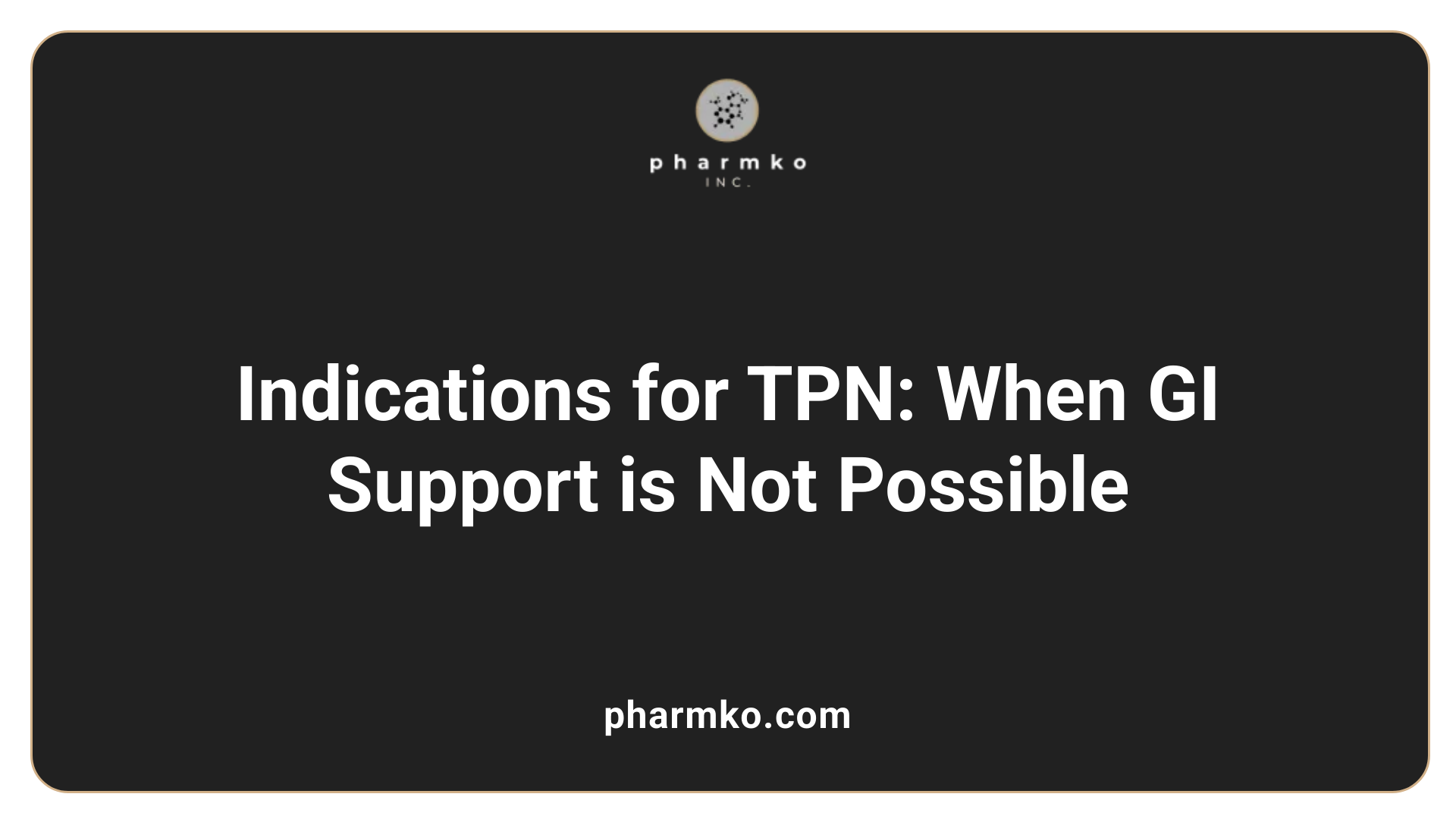
What are the main indications for Total Parenteral Nutrition (TPN)?
TPN is primarily used when an individual's gastrointestinal (GI) system cannot adequately process or absorb nutrients. This situation may arise due to various medical conditions or surgical interventions.
Conditions impairing gastrointestinal function include bowel obstructions, severe malabsorption syndromes, and high-output fistulas that drain excessive intestinal fluids. These conditions prevent normal enteral feeding and may threaten nutritional status.
Bowel obstruction and high-output fistulas are common reasons for TPN. Patients with prolonged or complete bowel obstructions or with fistulas producing significant intestinal fluid loss often require intravenous nutrition to maintain their health.
Gastrointestinal bleeding and malabsorption syndromes, such as Crohn's disease or radiation enteritis, can compromise nutrient absorption, necessitating TPN. In cases where oral or enteral intake is insufficient or impossible due to these conditions, TPN provides essential nutrients directly into the bloodstream.
Postoperative and oncologic contexts also often require TPN. After major abdominal surgeries, especially those involving bowel resection or anastomosis, patients may temporarily need TPN until gut function recovers. Similarly, cancer patients undergoing treatments like chemotherapy may experience mucosal damage and decreased intake, making TPN a vital support.
Severe burns or trauma cases are another indication, as the body's metabolic demand increases significantly, and maintaining adequate nutrition is crucial for healing and recovery.
In summary, TPN is indicated when patients cannot meet their nutritional needs through the GI tract, due to conditions like bowel dysfunction, obstructions, fistulas, bleeding, malabsorption, or severe systemic trauma. Proper assessment ensures its appropriate use, helping prevent nutritional deficits during critical illness or recovery.
Contraindications and Precautions for TPN Use
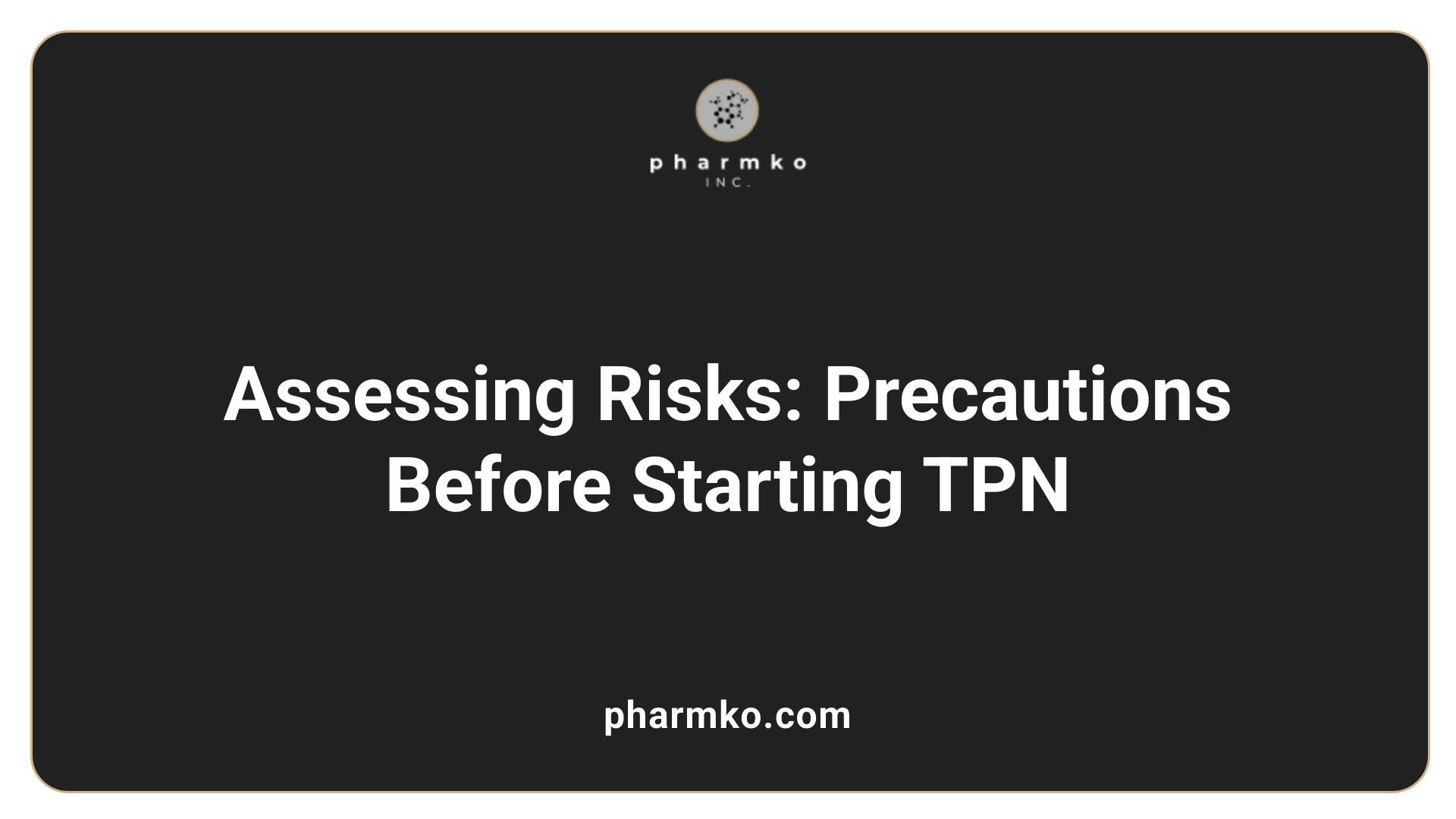
What are the contraindications for TPN?
The decision to initiate total parenteral nutrition (TPN) is based on careful evaluation of the patient’s overall condition and specific medical circumstances. TPN is contraindicated in cases where its risks outweigh potential benefits.
One primary contraindication is irreversible gastrointestinal (GI) failure. If the GI tract cannot be used at all for nutritional intake, TPN becomes a necessary alternative; however, in certain scenarios where other options exist or reversible conditions are present, TPN may be avoided.
Severe metabolic disturbances or allergies to components of the TPN mixture are also absolute contraindications. Patients with severe allergies—such as to amino acids, lipids, or electrolytes involved in TPN—should not receive this form of nutrition.
In infants, especially those with extremely short bowel segments, TPN may be contraindicated if the remaining intestine is less than approximately 8 centimeters, as they are unlikely to tolerate TPN effectively given their limited absorptive capacity.
Patients in a critical state with significant cardiovascular instability or terminal illnesses may not benefit from TPN and might experience more harm than good. When a patient’s condition is stable enough or when enteral feeding remains a viable option, TPN should generally be avoided.
Moreover, TPN is not recommended solely for short-term use (less than 72 hours) in well-nourished adults. Its use is typically reserved for cases where nutritional support extends beyond a week or when the gut cannot be used for an extended period.
In summary, TPN should only be employed in situations where indications are clear, and contraindications such as irreversible GI failure, severe metabolic issues, or the availability of functional enteral nutrition are absent. Judicious use of TPN minimizes risks and optimizes patient outcomes.
More information about TPN contraindications can be found by searching for "contraindications for TPN administration" in trusted medical sources.
Understanding the Risks and Complications of TPN
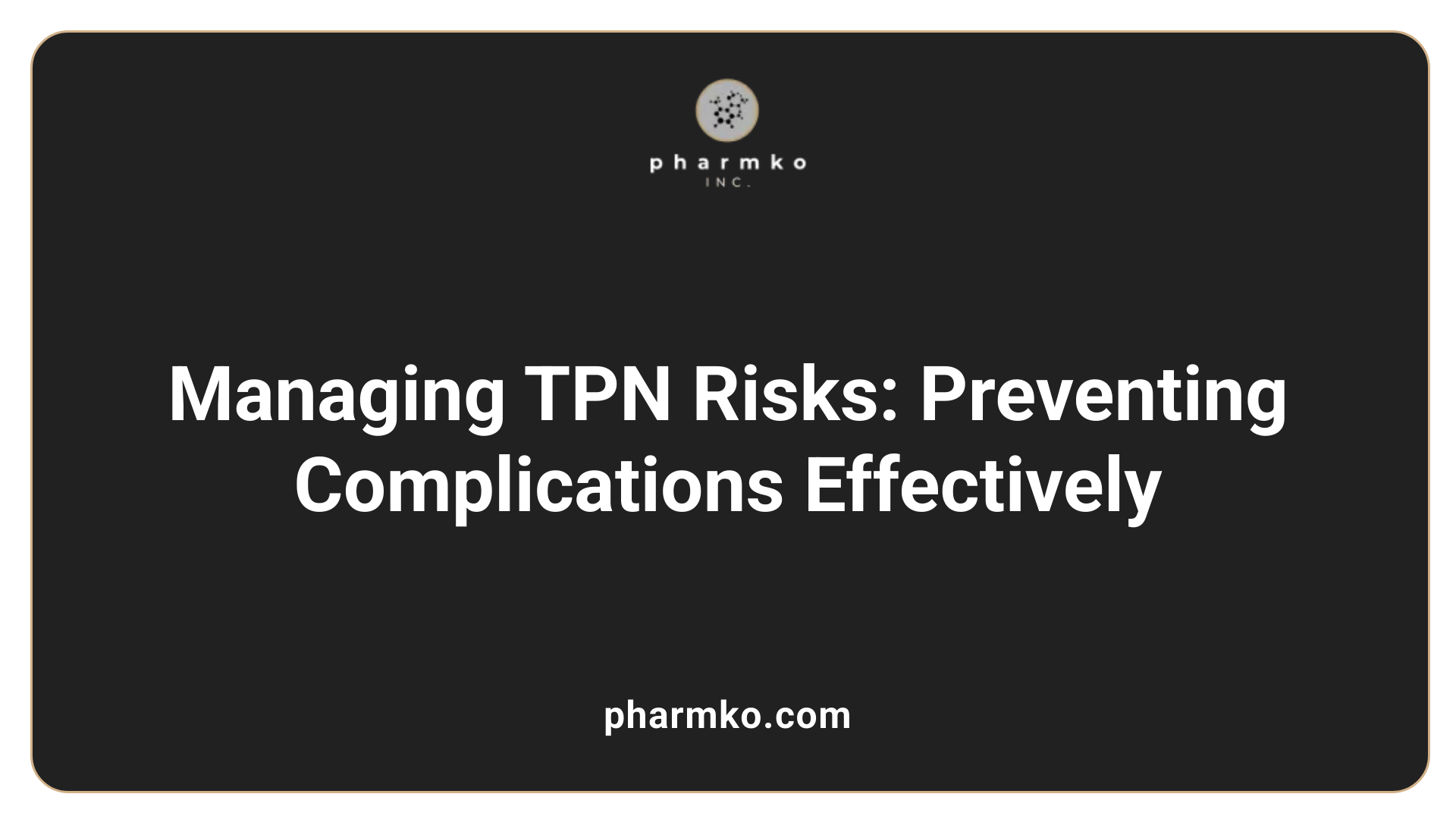
What are the common complications of TPN?
Total parenteral nutrition (TPN) is a vital treatment for patients with impaired gastrointestinal function, but it carries potential risks that healthcare providers must carefully manage.
One primary concern involves infections related to central venous catheters used for TPN administration. These can manifest as bloodstream infections (septicemia) or local infections at the insertion site. Such infections can become severe very quickly, threatening the patient's life if not promptly diagnosed and treated.
Metabolic disturbances are also frequent. These include hyperglycemia, a condition marked by high blood sugar levels, and electrolyte imbalances, which can affect the heart, muscles, and nervous system. Refeeding syndrome, a dangerous shift of fluids and electrolytes during the initiation of nutritional therapy, is particularly prevalent in malnourished patients or during rapid infusion.
Prolonged TPN use can lead to liver problems, including cholestasis—a decrease or stoppage of bile flow—potentially advancing to fibrosis or cirrhosis over time. These hepatic complications are serious and may require modifications in therapy or discontinuation of TPN.
Bone health issues such as osteoporosis and osteomalacia may develop due to deficiencies or imbalances in calcium, phosphate, and vitamin D, which are common in long-term TPN regimens.
Venous thrombosis and vascular injury are risks associated with catheter placement. These complications involve clot formation or damage to the vessel wall, which can compromise access and increase the risk of embolism.
Other potential risks include pneumothorax or air embolism during catheter insertion. Overall, frequent monitoring of serum electrolytes, blood glucose, liver function, and vigilant infection control practices are vital to reducing these risks.
In summary, while TPN offers life-saving nutritional support, its use requires rigorous oversight to prevent and manage complications effectively.
Guidelines for Safe and Effective TPN Administration
What are the guidelines for TPN administration and dosing?
The administration of Total Parenteral Nutrition (TPN) requires stringent adherence to safety protocols and careful individualization of nutrient formulations. The initial step involves establishing a secure central venous access, such as a PICC line or a tunneled catheter, to safely deliver hyperosmolar solutions. Proper aseptic technique during catheter placement and maintenance is vital to prevent bloodstream infections.
Dosing must be tailored to each patient’s unique nutritional requirements, which depend on factors like age, weight, metabolic demands, and clinical condition. Established guidelines from professional organizations like the American Society for Parenteral and Enteral Nutrition (ASPEN) recommend specific ranges for macronutrients and micronutrients. For example, adult caloric needs typically range from 25 to 30 kcal/kg/day, with protein intake around 1.5 g/kg/day, and lipids around 1 g/kg/day. Carbohydrate provision via dextrose should be carefully calibrated to avoid hyperglycemia, especially in critically ill patients.
Monitoring is integral to safe TPN therapy. Blood glucose levels, serum electrolytes, liver function tests, and serum proteins should be checked regularly. Early in therapy, more frequent assessments—such as daily or every 24-48 hours—are necessary to adjust doses and prevent complications like electrolyte imbalances, refeeding syndrome, or overfeeding.
Dose adjustments are based on ongoing evaluations of the patient’s laboratory parameters, clinical response, and metabolic tolerance. As the patient stabilizes and nutritional goals are met, adjustments can be made, tapering or increasing nutrients as indicated. Special considerations are given to vulnerable populations, such as neonates or critically ill adults, to optimize safety and efficacy.
In summary, the key to effective TPN management lies in meticulous planning, vigilant monitoring, and adaptable dosing to meet the evolving needs of the patient while minimizing risks. Following these guidelines ensures that TPN provides maximal nutritional support with minimal adverse effects.
Monitoring and Managing TPN Throughout Therapy
How is TPN monitored and managed during therapy?
Effective management of Total Parenteral Nutrition (TPN) relies on vigilant monitoring and timely adjustments. During therapy, patients undergo regular biochemical assessments to ensure nutritional balance and prevent complications. These tests include measuring electrolytes such as sodium, potassium, chloride, and bicarbonate, as well as blood glucose levels to detect hyperglycemia or hypoglycemia early.
Liver function tests and renal function markers are also essential components of the monitoring process, helping to identify hepatotoxicity or kidney issues that may arise from prolonged TPN use. In addition, serum triglycerides are checked to prevent lipid overload, and micronutrient levels such as vitamins and trace elements are assessed periodically.
Clinical assessments play an equally vital role. Healthcare professionals monitor vital signs, fluid output, body weight changes, and look for signs of infection, such as fever or localized redness at catheter sites. Regular inspection and care of the venous access are crucial to minimize risks of bloodstream infections.
The frequency of these evaluations varies depending on the patient's stability and the duration of TPN therapy. Typically, daily biochemical tests are performed during initial stages or unstable periods, while assessments may shift to weekly or monthly in stable, long-term cases.
Managing TPN requires a multidisciplinary team approach. Physicians determine the nutritional formulas and oversee overall care, dietitians tailor the composition to meet specific nutritional needs, nurses ensure aseptic technique and correct infusion practices, and pharmacists prepare and verify the TPN admixtures.
Early detection of metabolic and infectious complications is vital. Intervention might include adjusting glucose infusion rates to manage hyperglycemia, correcting electrolyte imbalances promptly, or administering antibiotics and removing infections. Continuous evaluation and open communication among team members help prevent adverse events and optimize patient outcomes.
Special Clinical Scenarios and the Use of TPN
In which clinical scenarios is TPN particularly beneficial?
Total parenteral nutrition (TPN) is vital in cases where the gastrointestinal (GI) tract cannot function properly or cannot be used safely for feeding. It is especially beneficial in situations such as bowel obstruction, short bowel syndrome, or intestinal pseudo-obstruction, where the GI system fails to absorb nutrients effectively. When high-output fistulas or severe GI ischemia occur, TPN provides a lifesaving alternative to sustain nutritional needs.
Patients with severe diarrhea, vomiting, or post-operative complications like leaks or disordered motility also benefit from TPN, as enteral nutrition may be contraindicated or poorly tolerated. Critically ill, hypermetabolic, or traumatized patients, including those with gastrointestinal failure due to disease or injury, often require TPN for adequate nutrient delivery.
Long-term support becomes essential when enteral feeding is unachievable for more than a week. Conditions like severe pancreatitis, where feeding through the gut is risky, are also indications for TPN. By bypassing the GI tract, TPN ensures these vulnerable patients receive necessary calories, proteins, vitamins, and minerals.
In essence, TPN offers crucial nutritional support in complex clinical situations where maintaining gut integrity and function is impossible or inadvisable. It prevents deterioration from malnutrition and supports recovery in high-risk scenarios, making it an indispensable component of advanced medical care for selected patients.
The Role of TPN in Pediatric and Neonatal Care
What is the role of TPN in specific patient populations and conditions?
Total parenteral nutrition (TPN) is essential for infants and children who cannot receive adequate nutrition through their gastrointestinal (GI) tract. It is particularly important in managing specific conditions that impair digestion, absorption, or motility.
In neonatal care, TPN is indicated for immature or congenital gastrointestinal malformations, which hinder normal feeding. For preterm infants diagnosed with necrotizing enterocolitis—a serious inflammatory disease affecting the intestines—TPN provides critical nutritional support during bowel recovery phases.
Many infants and children with severe GI defects, such as short bowel syndrome, depend on long-term TPN to meet their nutritional needs. This dependence is often due to the inability of damaged or absent bowel segments to absorb nutrients effectively.
Preparing TPN for pediatric and neonatal patients involves meticulous customization. The formulation must deliver adequate calories, proteins, lipids, vitamins, and minerals, all tailored to the infant’s or child's specific weight and health status. Precise dosing and component adjustments are vital to ensure proper growth and development.
Monitoring neonatal TPN requires vigilance to avoid metabolic complications such as electrolyte imbalances, hyperglycemia, and infections. Regular assessment of blood glucose, electrolytes, liver function tests, and infection signs is necessary. Due to their small blood volume, neonates are more sensitive to fluid overload and electrolyte disturbances, making careful supervision critical.
Special considerations in neonatal TPN include using central venous access with aseptic technique, avoiding infections, and ensuring stability of the infused solutions. Early detection of complications allows prompt intervention, safeguarding the fragile health of these vulnerable patients.
In summary, TPN plays a pivotal role in supporting neonatal and pediatric patients with serious gastrointestinal impairments. It helps sustain growth, prevent malnutrition, and facilitate recovery from complex conditions when enteral feeding cannot be used safely or effectively.
Balancing Benefits and Long-term Risks of TPN
How is TPN balanced between benefits and risks?
Total parenteral nutrition (TPN) plays a critical role in supporting patients with severe gastrointestinal conditions or injuries where enteral feeding is not possible or contraindicated. Its primary benefit lies in providing complete nutritional support, promoting tissue healing, supporting growth in infants, and preventing malnutrition during critical illness.
However, the use of TPN is not without long-term risks. Prolonged TPN therapy can lead to complications such as metabolic disturbances, including hyperglycemia, electrolyte imbalances, and hypertriglyceridemia. Liver problems like cholestasis and hepatobiliary disease may also develop, along with bone demineralization, leading to osteoporosis or fractures.
To effectively balance these benefits and potential risks, healthcare providers employ careful patient selection, ensuring TPN is appropriate and necessary. Formulations are tailored to meet individual nutritional needs while minimizing excesses that could lead to adverse effects.
Monitoring is paramount. Regular checks of serum electrolytes, glucose levels, liver enzymes, triglycerides, and bone health markers help detect early signs of complications. Limiting the duration of TPN, especially in long-term cases, and prioritizing the rapid transition to enteral nutrition whenever feasible further reduce risks.
Strategies for minimizing long-term adverse effects
Multidisciplinary teams—including physicians, dietitians, pharmacists, and nursing staff—coordinate to optimize the TPN regimen. They focus on precise dosing, electrolyte management, and adjusting formulations as the patient’s condition evolves.
Early intervention for emerging problems, such as adjusting glucose control in hyperglycemia or adding bone-supporting therapies, can mitigate complications.
Additionally, using advanced catheter techniques and strict aseptic protocols decrease infection risks, another important aspect of long-term TPN care.
Importance of multidisciplinary care
Successfully managing TPN’s risks and benefits relies on a team of specialists working together. Continuous education, vigilant monitoring, and timely adjustments ensure that patients receive the necessary nutrition without undue harm. This comprehensive approach enhances recovery, preserves organ function, and improves overall outcomes.
| Aspect | Concern | Management Strategy |
|---|---|---|
| Nutritional adequacy | Malnutrition or overfeeding | Tailored formulations, regular assessment |
| Metabolic stability | Hyperglycemia, electrolyte imbalances | Frequent blood tests, insulin adjustments |
| Liver health | Cholestasis, hepatobiliary disease | Limiting TPN duration, cycling infusion |
| Bone health | Osteoporosis | Supplementation, early mobilization |
| Infection risk | Catheter-related bloodstream infections | Strict aseptic technique, vascular access monitoring |
The Ethical and Practical Aspects of TPN Use
What are the ethical considerations associated with TPN?
Using Total Parenteral Nutrition (TPN) involves several ethical challenges. Foremost is respecting patient autonomy by ensuring patients are fully informed about the potential benefits and risks of the therapy. Discussions should include the patient’s wishes, quality of life considerations, and prognosis.
Decisions about initiating or discontinuing TPN are often complex, involving a multidisciplinary team that includes physicians, dietitians, nurses, and, crucially, the patient's consent. It's vital to evaluate whether the therapy aligns with the patient's goals and values, especially in cases of severe illness or terminal conditions.
Resource allocation is another ethical aspect, particularly when TPN is costly and requires significant medical resources, which should be justified based on potential benefit.
In situations where the prognosis is poor and TPN may only extend suffering, clinicians face the delicate task of balancing beneficence (doing good) with non-maleficence (avoiding harm). This often involves conversations about the goals of care, with an emphasis on palliative approaches if appropriate.
Careful, transparent communication is essential to establish trust, obtain informed consent, and ensure that decisions about TPN reflect ethical principles. Ultimately, tailoring TPN decisions to each patient’s unique circumstances and wishes supports ethical practice in nutritional support management.
Concluding Insights on TPN Utilization
Total Parenteral Nutrition is an indispensable tool in modern medicine, capable of lifesaving and life-sustaining effects when used appropriately. Understanding its indications, managing associated risks, and adhering to guidelines ensure optimal patient outcomes. The decision to employ TPN must always involve careful consideration of contraindications, clinical needs, and ethical principles, with vigilant monitoring to mitigate complications. As health care advances, continued research and interdisciplinary collaboration will enhance the safety and efficacy of this vital therapy, reinforcing its role in patient-centered care.
References
- Total Parenteral Nutrition - StatPearls
- Parenteral Nutrition: What it Is, Uses & Types
- Indication and Appropriate use of TPN (Total Parenteral ...
- Indications for total parenteral nutrition in the hospitalized ...
- Total Parenteral Nutrition (TPN)
- Conditions Treated - Total Parenteral Nutrition
- Parenteral Nutrition Overview - PMC







